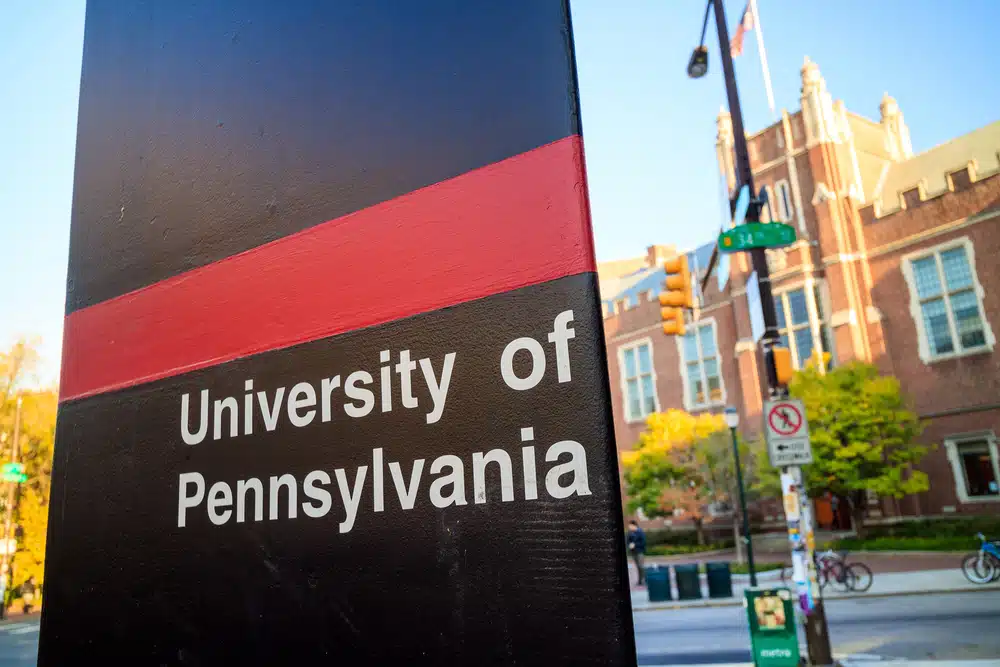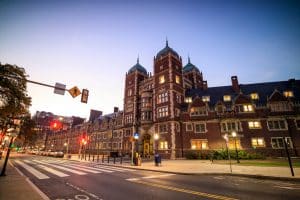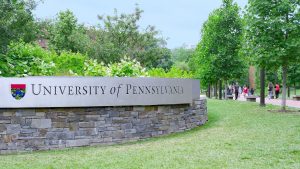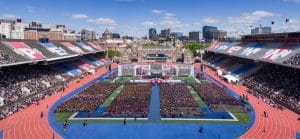Discovering How Big UPenn Really Is
The University of Pennsylvania, commonly referred to as UPenn, is globally renowned for its prestige, history, and educational excellence. But, one aspect that may surprise many is the sheer size of this educational institution. Here, we take a deep dive into understanding the size of UPenn, from its physical scale to its expansive student body.
Understanding the Size of UPenn
The Campus: A Physical Perspective
The University of Pennsylvania’s campus spans 302 acres and is situated in the University City section of West Philadelphia. This incorporates a blend of academic buildings, student residences, athletic facilities, and open green spaces.
The campus is a sprawling landscape that offers students a multitude of opportunities to explore and engage with their surroundings. From the historic architecture of College Hall to the state-of-the-art laboratories in the Science Center, each building on campus has its own unique story to tell.
As students walk through the campus, they are greeted by vibrant green spaces, such as the iconic Locust Walk, where they can relax, study, or socialize with fellow peers. The open areas provide a sense of tranquility amidst the bustling academic environment, allowing students to find their own peaceful corners to reflect and recharge.
Furthermore, the campus is not limited to just academic and residential spaces. It also boasts a variety of athletic facilities, including a state-of-the-art gymnasium, tennis courts, and a track field. These facilities cater to the diverse interests of the student body, encouraging them to pursue a healthy and active lifestyle.
The Student Body: A Demographic Perspective
When it comes to the size of the student body, UPenn is home to more than 20,000 students consisting of undergraduates, postgraduates, and doctoral candidates. The significant student population is a bid to cultivate a diverse and vibrant community of learners from various localities, cultures, and academic fields.
With such a large student body, UPenn becomes a microcosm of the world, where students from different backgrounds come together to learn, grow, and collaborate. The university takes pride in its commitment to inclusivity and strives to create an environment where every student feels valued and supported.
Moreover, the size of the student body allows for a wide range of academic opportunities. UPenn offers a vast array of majors, minors, and interdisciplinary programs, ensuring that students can pursue their passions and tailor their education to their individual interests. The diverse nature of the student body also provides access to a rich network of peers with distinctive perspectives and unique insights, fostering a culture of intellectual curiosity and collaboration.
Outside of the classroom, the large student population contributes to a vibrant campus life. There are numerous student organizations, clubs, and extracurricular activities that cater to a wide range of interests. Whether it’s joining a cultural club, participating in community service, or engaging in research projects, students have endless opportunities to explore their passions and make a lasting impact on campus and beyond.
The History of UPenn’s Expansion
The Founding Years and Initial Growth
Founded in 1740 by Benjamin Franklin, UPenn commenced as a small institution. It made steady expansions over the next two centuries, with significant leaps occurring during the 19th and 20th centuries. The expansions reflected the university’s evolution in providing holistic education, combining various disciplines under one roof.
As UPenn grew, it became a hub for intellectual and cultural exchange. The campus buzzed with the energy of students and faculty, eager to explore new frontiers of knowledge. The university’s commitment to academic excellence attracted renowned scholars and thinkers, further fueling its expansion.
During the 19th century, UPenn witnessed remarkable growth in its infrastructure. The construction of new academic buildings and dormitories transformed the campus into a vibrant community. Students from different backgrounds came together, forming lifelong friendships and engaging in intellectual debates that shaped their understanding of the world.
The 20th century brought even more significant changes to UPenn. The university embraced the changing landscape of education, adapting to the demands of a rapidly evolving society. It expanded its curriculum to include emerging fields of study, such as computer science, environmental studies, and biotechnology.
Significant acquisitions occurred during the 1960s and 1970s, paving the way for the construction of modern facilities, research centers, and libraries that now define UPenn’s innovative and technologically advanced academic sphere. These developments have put the university at the forefront of academic development and discovery.
Modern Developments and Future Plans
In recent years, UPenn has continued to expand. It acquired the former postal lands adjacent to the Schuylkill River, leading to the development of Penn Park, a beautiful urban park offering recreational facilities for students and the community.
Penn Park has become a beloved gathering place for students, providing a serene escape from the bustling campus. With its lush green spaces, walking trails, and sports fields, it offers a perfect balance between relaxation and physical activity. Students often gather here to study, play sports, or simply enjoy the beauty of nature.
Future plans include continuing to develop more accessible spaces for collaborative learning, innovative research, and community engagement. This will involve ongoing adjustments to the physical campus framework to ensure it’s equipped to facilitate dynamic learning experiences and the broader mission of the university.
UPenn envisions a future where its campus becomes a living laboratory, fostering interdisciplinary collaboration and pushing the boundaries of knowledge. The university aims to create state-of-the-art research facilities that attract top-tier faculty and students from around the world.
Additionally, UPenn is committed to strengthening its ties with the local community. It plans to establish more outreach programs, providing educational opportunities to underprivileged students and fostering a sense of social responsibility among its students.
As UPenn’s expansion continues, it remains dedicated to its founding principles of intellectual curiosity, academic rigor, and societal impact. The university strives to create an environment where students can thrive, explore their passions, and make a positive difference in the world.
Comparing UPenn’s Size to Other Universities
Ivy League Comparisons
When it comes to size, UPenn stands out among the Ivy League universities. With its sprawling campus, UPenn covers a wider area compared to Yale and Princeton. However, in terms of physical size, UPenn falls slightly short when compared to the vast campuses of Cornell and Columbia.
But size is not just about the physical space. UPenn’s student population also plays a significant role in its overall size. With a large number of students, UPenn surpasses Dartmouth and Brown in terms of student population. This showcases UPenn’s commitment to providing a comprehensive academic experience with a broad array of disciplines for study.
Nationwide University Comparisons
On a nationwide scale, UPenn continues to impress with its size, particularly as an urban campus. When compared to other urbanized universities such as NYU and USC, UPenn boasts a more spacious campus. The abundance of green spaces and open areas on campus provide students with a refreshing environment for learning and socializing.
Moreover, UPenn’s student body is also larger than that of NYU, further solidifying its position as one of the bigger urban campuses in the country. The diverse and vibrant student community at UPenn adds to the overall richness of the university experience.
However, when compared to massive public institutions like Ohio State University (OSU) or the University of Texas at Austin (UT Austin), UPenn appears smaller in both student population and physical space. These public universities often have sprawling campuses and enroll a significantly larger number of students.
Despite this, UPenn’s size should not be underestimated. Its combination of a spacious campus, diverse student population, and comprehensive academic offerings make it a standout institution among its peers.
Implications of UPenn’s Size
Impact on Student Life and Culture
The size of UPenn greatly influences student life and culture. The expansive campus provides students with a variety of recreational, learning, and living spaces. Students can explore the numerous parks, gardens, and open areas on campus, creating opportunities for outdoor activities and social gatherings. The size of the student body also promotes diversity and an array of experiences as students from different backgrounds and cultures come together in this vibrant community.
With a larger student population, UPenn offers a wide range of student organizations and clubs catering to various interests and passions. From academic clubs to performing arts groups, there is something for everyone. These extracurricular activities not only provide opportunities for students to pursue their passions but also foster a sense of community and belonging.
Moreover, the size of UPenn allows for a rich and dynamic social scene. Students can attend a variety of events, such as concerts, lectures, and art exhibitions, organized by the university or student groups. This vibrant social environment encourages students to explore new interests, meet new people, and broaden their horizons.
Influence on Academic Opportunities and Resources
UPenn’s scale also facilitates a vast array of academic opportunities and resources. With a wide range of departments and fields, students can enjoy a comprehensive academic experience tailored to their interests. The size of the university enables the recruitment of top-notch faculty members who are experts in their respective fields. This means that students have access to world-class professors and researchers who can provide valuable insights and mentorship.
Additionally, UPenn’s size allows for a diverse and extensive library system. The university boasts multiple libraries, each specializing in different subjects, providing students with a wealth of resources for their research and studies. Whether it’s a rare book, a scientific journal, or a digital database, students can easily find the materials they need to excel academically.
Furthermore, the size of UPenn attracts a wide range of guest speakers and visiting scholars. The university regularly hosts lectures, conferences, and symposiums featuring renowned experts from various fields. This offers students the opportunity to engage with leading intellectuals and gain insights beyond the classroom.
Moreover, UPenn’s large alumni network plays a significant role in providing academic opportunities. With a vast number of successful alumni spread across different industries and sectors, students have access to a wide range of internships, research opportunities, and career connections. The size of the university’s alumni network ensures that students can tap into a diverse and extensive professional network.
Overall, the size of UPenn has far-reaching implications for student life, culture, and academic opportunities. The expansive campus, diverse student body, and extensive resources contribute to a vibrant and enriching college experience. Whether it’s through extracurricular activities, academic pursuits, or networking opportunities, UPenn’s size enhances the overall educational journey of its students.
Navigating the Large UPenn Campus
When it comes to navigating the large UPenn campus, students and visitors are fortunate to have a multitude of transportation options at their disposal. In addition to the traditional modes of transportation like walking, biking, and taking public transportation, UPenn offers a comprehensive shuttle service that makes getting around campus a breeze.
The campus shuttles are not only convenient but also environmentally friendly. They run on a regular schedule and make stops at key locations throughout the campus, ensuring that students and visitors can easily travel from one end of the campus to the other without any hassle. The shuttles are equipped with comfortable seating and provide a great opportunity for students to catch up on their reading or simply relax during their commute.
For those who prefer a more active mode of transportation, UPenn also offers bike rentals. This is a fantastic option for students who want to get some exercise while getting to their classes or exploring the campus. The bike rental program is affordable and easy to use, allowing students to pick up a bike at one location and drop it off at another, making it a convenient and flexible option.
UPenn is also known for its pedestrian-friendly pathways. The campus is designed with wide sidewalks and well-maintained walkways, making it easy and enjoyable to walk from one building to another. These pathways are not only functional but also aesthetically pleasing, with beautiful landscaping and green spaces that create a peaceful and inviting atmosphere.
Key Landmarks and Buildings to Know
As students and visitors navigate the expansive UPenn campus, there are several key landmarks and buildings that they should be aware of. These landmarks not only serve as important points of reference but also offer various resources and opportunities for the students.
One of the most iconic buildings on campus is College Hall. This historic building is not only visually stunning but also houses important administrative offices and classrooms. It serves as a central hub for students, providing them with access to essential services and resources.
Another notable building on campus is the Van Pelt Library. This state-of-the-art facility is a treasure trove of knowledge, with an extensive collection of books, journals, and digital resources. It offers students a quiet and comfortable space to study, collaborate, and conduct research.
For those interested in cutting-edge technology and scientific advancements, the Singh Center for Nanotechnology is a must-visit. This high-tech facility is dedicated to nanoscale research and innovation. It houses advanced laboratories, cutting-edge equipment, and hosts various events and conferences that bring together experts from around the world.
These are just a few examples of the many landmarks and buildings that make up the UPenn campus. Each building has its own unique history and purpose, contributing to the vibrant and dynamic atmosphere of the university.
Final Thoughts
The size of UPenn is indeed significant, not just in terms of physical dimensions but also in the size of opportunities and experiences offered. From its sprawling campus to its diverse student body, UPenn is a big, bustling hub for academic excellence, community, and innovation. Navigating the campus is made easy with the multitude of transportation options available, and exploring the key landmarks and buildings adds depth and richness to the overall UPenn experience.
How AdmissionSight Can Help You With College Admissions
AdmissionSight is a college consulting firm that provides personalized assistance to students throughout the college admissions process. Here are some ways that AdmissionSight can help you:
Admissions strategy: AdmissionSight can help you develop a strategic plan for your college application process. Our professional consultants can assist with identifying schools that are a good fit for your academic, extracurricular, and personal goals and help you plan and prioritize your application strategy.
Application review: AdmissionSight can review your application and provide feedback on how to improve it. We can offer suggestions on making your application stand out and highlighting your strengths and unique qualities.
Essay coaching: AdmissionSight can help you craft compelling essays that showcase your personality, goals, and achievements. We can guide you through the essay writing process and provide feedback on your drafts to help you refine your writing.
Interview preparation: AdmissionSight can provide interview coaching to help you feel confident and prepared for college interviews. Our experts can offer tips on how to present yourself professionally and how to answer common interview questions.
Extracurricular planning: AdmissionSight can help you plan and develop your extracurricular activities to make them more impactful and meaningful. We can suggest activities that align with your interests and goals and provide guidance on demonstrating your leadership and initiative.
Overall, AdmissionSight can provide valuable guidance and support throughout the college admissions process to help you maximize your chances of getting accepted into the college of your choice.
With a high success rate of over 75%, we have built a strong network in the past decade. Book an initial consultation today, free of charge!










































